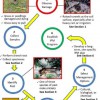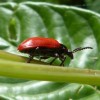 Mole crickets can become serious pests of turfgrasses, pastures, and vegetable seedlings. The first step in determining if you have a mole cricket problem at a site is to compare the existing damage to pictures of known mole cricket damage. If the damage is likely caused by mole crickets, specimens should be obtained and the pest identified. You then should determine if the number of mole crickets is great enough to cause an unacceptable level of damage and decide what control measures should be used. Eventually, a long-term, sustainable integrated pest management (IPM) program should be established. This 20-page guide will help you identify mole cricket infestations and manage them effectively and economically while minimizing environmental impacts. Written by C. R. Kerr, N. C. Leppla, E. A. Buss, and J. H. Frank, and published by the UF Department of Entomology and Nematology, May 2014.
Mole crickets can become serious pests of turfgrasses, pastures, and vegetable seedlings. The first step in determining if you have a mole cricket problem at a site is to compare the existing damage to pictures of known mole cricket damage. If the damage is likely caused by mole crickets, specimens should be obtained and the pest identified. You then should determine if the number of mole crickets is great enough to cause an unacceptable level of damage and decide what control measures should be used. Eventually, a long-term, sustainable integrated pest management (IPM) program should be established. This 20-page guide will help you identify mole cricket infestations and manage them effectively and economically while minimizing environmental impacts. Written by C. R. Kerr, N. C. Leppla, E. A. Buss, and J. H. Frank, and published by the UF Department of Entomology and Nematology, May 2014.
http://edis.ifas.ufl.edu/in1021
Tag: J. H. Frank
Florida's Established Arthropod Weed Biological Control Agents and Their Targets (ENY853/IN779)
 Around 5% of the plant species deliberately introduced into Florida for crop production and horticultural uses have invaded sensitive aquatic and terrestrial natural areas as well as improved pastures. One of the reasons they become invasive is they lack the natural enemies that limit their reproduction. Biological control reunites these natural enemies (usually arthropods) with their host plants to selectively weaken and suppress the invasive weeds. This 3-page fact sheet was written by J. P. Cuda and J. H. Frank, and published by the UF Department of Entomology and Nematology, October 2013.
Around 5% of the plant species deliberately introduced into Florida for crop production and horticultural uses have invaded sensitive aquatic and terrestrial natural areas as well as improved pastures. One of the reasons they become invasive is they lack the natural enemies that limit their reproduction. Biological control reunites these natural enemies (usually arthropods) with their host plants to selectively weaken and suppress the invasive weeds. This 3-page fact sheet was written by J. P. Cuda and J. H. Frank, and published by the UF Department of Entomology and Nematology, October 2013.
http://edis.ifas.ufl.edu/in779
Saddleback Caterpillar Acharia stimulea (Clemens) (Insecta: Lepidoptera: Limacodidae) (EENY522/IN923)
 Acharia stimulea is best known as a medically significant species. Its spines are strong, acutely pointed, and hollow. They embed deeply into tissue and break off, and can interrupt healing as the protoplasm from the venom glands dries into the tissue area. The venom itself can cause a systemic condition called erucism or acute urticaria, for which severe symptoms may include migraines, gastrointestinal symptoms, asthma complications, anaphylactic shock, rupturing of erythrocytes, and hemorrhaging. This 9-page fact sheet was written by Christopher S. Bibbs and J. Howard Frank, and published by the UF Department of Entomology and Nematology, March 2012.
Acharia stimulea is best known as a medically significant species. Its spines are strong, acutely pointed, and hollow. They embed deeply into tissue and break off, and can interrupt healing as the protoplasm from the venom glands dries into the tissue area. The venom itself can cause a systemic condition called erucism or acute urticaria, for which severe symptoms may include migraines, gastrointestinal symptoms, asthma complications, anaphylactic shock, rupturing of erythrocytes, and hemorrhaging. This 9-page fact sheet was written by Christopher S. Bibbs and J. Howard Frank, and published by the UF Department of Entomology and Nematology, March 2012.
http://edis.ifas.ufl.edu/in923
IPM147/IN853 How to Use Nematac® S against Pest Mole Crickets in Pastures
Revised! IPM147, a 3-page illustrated fact sheet by N.C. Leppla, J.H. Frank, and J.A. Graesch, discusses the use of the proprietary formulation of insect-parasitic nematode Steinernema scapterisci for use against mole crickets, which can severely damage Florida pastures. Published by the UF Department of Entomology and Nematology, June 2010.
http://edis.ifas.ufl.edu/in853
ENY853/IN779 Florida’s Established Arthropod Weed Biological Control Agents and Their Targets
ENY853, a 3-page fact sheet by J. P. Cuda and J. H. Frank, describes the role of biological control agents in controlling nonnative invasive weeds, lists the arthropod bilogical control agents that are established for seven invasive weeds, and provides links to additional resources. Includes references. Published by the UF Department of Entomology and Nematology, September 2009.
http://edis.ifas.ufl.edu/IN779